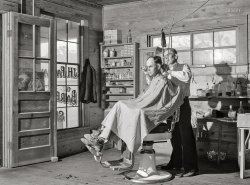
MAY CONTAIN NUTS

Search Shorpy
SHORPY ART

Framed or unframed, desk size to sofa size, printed by us in Arizona and Alabama since 2007. Explore now.
Join and Share
Ad-Free Shorpy
Shorpy is funded by you. Patreon contributors get an ad-free experience.
Learn more.

Recent comments
- Details, Details
- What's that building to the left of the tower?
- Coal Barges
- Bromo-Seltzer
- Inner harbor
- The Basin
- What a headache!
- Giant stepladder?
- Baldwin 62303
- Baldwin VO-1000
- Cold
- No expense spared
- Tough Guys
- Lost in Toyland
- And without gloves
- If I were a blindfolded time traveler
- Smoke Consumer Also Cooks
- Oh that stove!
- Possibly still there?
- What?!?
- $100 Reward
- Freeze Frame
- Texas Flyer wanted
- Just a Year Too Soon
- WWII -- Replacing men with women at the railroad crossing.
- Yes, Icing
- You kids drive me nuts!
- NOT An Easy Job
- I wonder
- Just add window boxes
Member Photos
The Shorpy
Print Emporium
Print Emporium
Search Shorpy
Search results -- 30 results per page
- Chicago Noir: 1942
- ... yard." View full size. Medium format negative by Jack Delano for the Office of War Information.
C&NW Yard This a hump ... Posted by Dave - 09/06/2011 - 1:38pm -
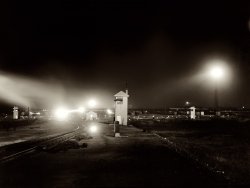
- Caboose Track: 1943
- ... Yard." View full size. 4x5 Kodachrome transparency by Jack Delano for the Office of War Information.
No Graffiti! In all of the ... Posted by Dave - 08/13/2012 - 4:34pm -
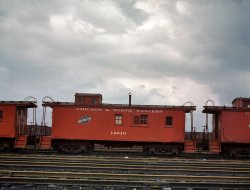
- Window Seat: 1943
- ... the giant freight locomotives." Medium-format negative by Jack Delano for the Office of War Information. View full size.
C&NW ... Posted by Dave - 08/31/2016 - 12:44am -
![Window Seat: 1943 May 1943. "Clinton, Iowa. Women wipers of the Chicago & North Western cleaning one of the giant freight locomotives." Medium-format negative by Jack Delano for the Office of War Information. View full size.
C&NW engineThis was a so-called "Northern" steam engine, with a 4-8-4 wheel arrangement. Another photo:
http://abpr.railfan.net/july98/07-06-98/cxnw001.jpg
A Twofer!A locomotive and a caboose, in the same picture.
Her official RR job title - WIPERReally, look it up. Railroader's know.
[Do they know when to use an apostrophe? - Dave]
Comment envyLove the caboose comment! It only took me a second to get it
(The Gallery, Jack Delano, Railroads)](https://www.shorpy.com/files/images/SHORPY-8d29254a.thumbnail.jpg)
- Upper M.C.: 1940
- ... Chunk, Pennsylvania." Medium format acetate negative by Jack Delano for the Farm Security Administration. View full size.
A Boy and ... Posted by Dave - 04/08/2020 - 7:42pm -
![Upper M.C.: 1940 August 1940. "Street in Upper Mauch Chunk, Pennsylvania." Medium format acetate negative by Jack Delano for the Farm Security Administration. View full size.
A Boy and His DogThe dog looks to be a perfect companion for the young lad on the sidewalk. The car driving toward us is a 1940 Ford Deluxe 4 door Sedan.
I guess it was true back thenI walked to school uphill both ways. Often wondered about this.
What is that word?Can someone please tell me how to say that name!! It has been bugging me for a long time and you just keep posting these picture, lol! I cant find any kind of pronunciation after a long and boring, nay, fruitless search on the google.
[Go to Google. Type this in the search box: Pronunciation of Mauch Chunk. - Dave]
Today --
(The Gallery, Dogs, Jack Delano, Kids, Small Towns)](https://www.shorpy.com/files/images/SHORPY-8c02902a.thumbnail.jpg)
- Conductor Cunningham: 1943
- ... the delivery is to be made." Medium-format negative by Jack Delano for the Office of War Information. View full size.
Poster in the ... Posted by Dave - 08/30/2016 - 10:36am -
![Conductor Cunningham: 1943 January 1943. "Freight operations on the Indiana Harbor Belt railroad between Chicago and Hammond, Indiana. Getting his waybills, Conductor Cunningham telephones his yardmaster with the number of cars he has to handle and where the delivery is to be made." Medium-format negative by Jack Delano for the Office of War Information. View full size.
Poster in the upper rightBuy Bonds! Win the War!
oh REAL-ly@Kcamp I know Adolph Treidler worked out of New York, but when he made that poster he must have been using a reference photo from the Norfolk & Western, because that's one of the better portraits of a Y6 Class I've seen, in the foreground.
Paper rolled into cylindersI wonder what the function was for the paper rolled into cylinders in front?
[I'd say print-outs of previous schedules, bundled for convenient storage. -tterrace]
Also, you never see anything with scissor extensions anymore, they're the most steampunk thing ever.
American ingenuity at workCoffee can used as a lampshade. Gotta love that.
Poster in Upper LeftAdolph Treidler poster from the early 1940s.
I like my coffee lightA pot light made from a coffee can (from 1943) will look great hanging over any kitchen island. Going to add it to my list of options.
Blue IslandChances are good the location is the Blue Island yard office. The rolled paper looks like stored train lists that came over teletype machines. Notice the two tubes (left side of image) that carried waybills, train lists and such over the pneumatic tube system to various offices within the yard.
Gibson in Hammond Indianamight also be where this pic was taken. The IHB had their main offices located there, along with a big hump (Classification) yard.
The Indiana Harbor Belt at Gibson is where the billing offices processed and mailed out their accounts payable.
Tube jobLove pics having anything to do with the 40's and trains. The pneumatic tubes remind me of a summer job I had once at a large wholesaler. I worked the central tube room and distributed the tubes to stations all over the building. Fun job and the learning curve was a straight line.
(The Gallery, Jack Delano, Railroads)](https://www.shorpy.com/files/images/SHORPY-8d24289a.thumbnail.jpg)
- While the City Sleeps: 1940
- ... Foggy night." Another noirish image from the prolific Jack Delano. Medium format nitrate negative. View full size.
A dark and ... Posted by Dave - 10/23/2013 - 9:38am -
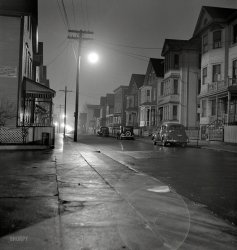
- Tune-Up: 1942
- ... what that little step is for. Medium-format negative by Jack Delano for the Office of War Information. View full size.
Before Fuel ... Posted by Dave - 07/14/2014 - 2:56pm -
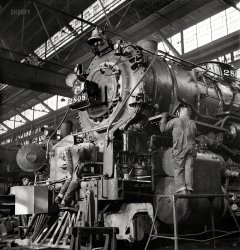
- Tracks in the Snow: 1942
- ... View full size. 4x5 Kodachrome transparency by Jack Delano.
C&NW RR Would anyone know from just the picture which ... Posted by Dave - 07/30/2012 - 10:04pm -
![Tracks in the Snow: 1942 December 1942. Three West Coast streamliners in the Chicago & North Western yards at Chicago. View full size. 4x5 Kodachrome transparency by Jack Delano.
C&NW RRWould anyone know from just the picture which streamliners are in the photo? I believe the one on the left with the front grill work might be the City of Portland, the other 2 would be going to Calif by way of the UP. Also there's a E6 A or B unit? facing towards the streamliner on the right.
[See comments in the detail view of this photo for a discussion of the streamliners. The one on the left is the City of Denver. - Dave]
Transition from SteamDave, I don't know what surprises me most; Tom Kelley (who claims to be an old railroad man) believing that Diesel Locomotives didn't arrive until 1958, or you for stating that "Diesel-electric locomotives had largely replaced steam power by the end of the 1940s."
[See clipping above for numbers. I think "largely replaced" is a fair characterization of the situation. - Dave]
For the record the first diesels appeared the early 1930s and the first streamlined non-steam trainsets (a matched locomotive and cars) was probably the UP's City of Salinas with the famous M-10000 locomotive, which if I'm not mistaken (and I probably am) was first exhibited at the 1933 Century of Progress Exposition in Chicago (love to see some photos of that btw). Dieselization proceeded at different rates depending on location. Western roads such as the UP, the Southern Pacific and the Santa Fe were quick to acquire diesels because of the dry conditions of the southwest in particular. Railroads with a lot of coal available made the transition more slowly - they had a cheap and ready source of fuel from the mines they serviced. Conversion did take place first on passenger trains and then on freight trains but of course there were exceptions to the "rule" as well. Suffice it to say that while they were being phased out, there were still plenty of steam engines running for much of the 1950s. The last steam locomotive to operate on a regular basis on a class 1 US railway was on the Norfolk and Western (a big coal hauler), which was about the time that the last steam engines on the Canadian National made their final runs.
Rail Dieselization Nears Completion (1953)New York Times, August 9, 1953.
Streamlimers in 1942 ???? Don't think so!!!Sorry to be a skeptic, but being an old railroad worker, i have to question this one since the 'Streamliners' pictured here appear to be diesels which didn't come about until 1958.
[The streamliner on the left with the grille is the City of Denver, built in 1936. Wikipedia article. The heyday of the streamliner was in the 1940s and early 1950s. Diesel-electric locomotives had largely replaced steam power by the end of the 1940s. - Dave]
1942 ?????Are these units not diesels, which didn't arrive until 1958?
[Where did you get the idea the first diesels came out in 1958 ????? - Dave]
1942 C&NWFrom left to right the first set of passenger cars is for the C&NW Twin City 400 service. These cars arrived between 1939 and 1941. The second train is the City of Denver, the noise heard is for C&NW & Union Pacific railroads and the headlight does not have a hood over it, which means the train did not go to the west coast. The hood had to be used by any train or locomotives which came within 200 miles of the coast as to help it not be spotted by enemy boomers. Next is a single EMD E3/E6 (1939-1941). And on the last track is a C&NW E3/E6 with a City of San Francisco EMD E2 (1939).
snow clearanceInteresting to see that in the right foreground, snow has been cleared from around the switchpoints to prevent it from impeding their movement.
1953 statsDave, thanks for posting that. David P. Morgan wrote in TRAINS magazine that diesels were responsible for 90% of traffic in 1954, which comports well with the clipping.
DieselsThe Gulf Mobile and Ohio was the first Class 1 railroad in the country to completely dieselize. One of the major weekly magazines (Look, Life or something similar) did a photo essay showing the last steam run on the GM&O and one sad photo I remember was of a diesel switcher pulling down a water tank within sight of our house. GM&O used ALCO equipment almost exclusively on the Southern Division while they used EMDs above Bloomington Illinois. We did have a Baldwyn cab unit or two and a real abortion (we called it "The Catfish") that was a road switcher made by the Ingalls Ship Building company right after WWII. I think it was the only one they built and since the GM&O did a lot of traffic with Ingalls, they bought the funny looking critter as a good will gesture.
(The Gallery, Kodachromes, Chicago, Jack Delano, Railroads)](https://www.shorpy.com/files/images/1a34616u.thumbnail.jpg)
- Round Trip: 1943
- ... Engines at the roundhouse." Medium-format negative by Jack Delano for the Office of War Information. View full size.
In Altoona ... Posted by Dave - 01/08/2013 - 11:16am -
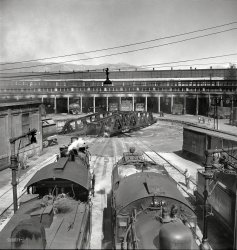
- Jones & Laughlin: 1941
- ... of the afternoon shift." Medium format acetate negative by Jack Delano. View full size.
Ravaged Given the vicissitudes of working in ... Posted by Dave - 10/24/2019 - 3:23pm -
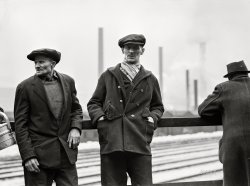
- Five Card Studs: 1943
- ... Stag counterpoint to the girls back home . Photo by Jack Delano for the Office of War Information. View full size.
Ahead of the ... Posted by Dave - 10/15/2013 - 9:58am -
![Five Card Studs: 1943 July 1943. Greenville, South Carolina. "Air Service Command. Men of the Quartermaster Truck Company of the 25th Service Group having a card game in one of the barracks." Stag counterpoint to the girls back home. Photo by Jack Delano for the Office of War Information. View full size.
Ahead of the gameThe "girls" needed several photos to get to the point of partial disrobing.
His ring-The handsome young gent in the tank top is wearing a ring very similar to my late father's square cut black onyx, and I thought of it and of him when I saw this photo. Though strangers, these men seem vaguely familiar, I suppose a residual long-ago memory of the military men who passed through our San Diego home during WW2 and Korea.
Great LightingThe photographer obviously didn't need to turn on the light over the table.
[The illumination is coming from a flood lamp out of frame at the upper right; among other things, note that the overhead bulb could not be shining on the top of its own shade. -tterrace]
High StakesI don't see any money on the table. I guess these Non-Coms are playing for cigarettes and apples.
Floodlight hazeThe light *is* just barely out of frame, as shown by the well-illuminated cigarette haze!
The Army Game.When I played a lot of poker in the 1950s, five card stud was always called the Army game.
Bilko's platoonI can't be he only one who remembers the shenanigans of Sgt. Ernie Bilko as he schemed to bilk his platoon of their meager payday earnings. This barracks scene looks like the model for the Bilko TV studio set. Even when I was in he Army in the early 1970s the poor infantry was still relegated to these wooden structures.
(The Gallery, Jack Delano, WW2)](https://www.shorpy.com/files/images/SHORPY_8d32067u.thumbnail.jpg)
- Naughty & Nice: 1941
- ... triple-dog-dare to take care of. Medium format negative by Jack Delano for the Farm Security Administration. View full size.
A Very ... Posted by Dave - 12/22/2018 - 11:04am -
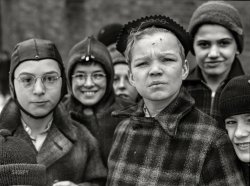
- Winter Sports: 1940
- ... First stop: the frozen flagpole. 35mm nitrate negative by Jack Delano. View full size.
At first glance The house and the scene ... Posted by Dave - 12/27/2012 - 7:50pm -
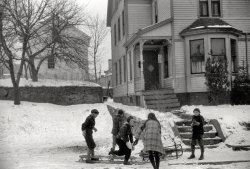
- Extra Starch: 1940
- ... the potatoes to be graded and weighed." 35mm Kodachrome by Jack Delano for the Farm Security Administration. View full size.
Starch ... Posted by Dave - 05/17/2016 - 12:48pm -
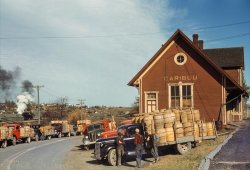
- An Uphill Climb: 1941
- ... Pennsylvania." Medium format acetate negative by Jack Delano for the Farm Security Administration. View full size.
A Bit of ... Posted by Dave - 11/05/2019 - 2:39pm -
![An Uphill Climb: 1941 January 1941. "Street in the mill district in Pittsburgh, Pennsylvania." Medium format acetate negative by Jack Delano for the Farm Security Administration. View full size.
A Bit of ClassIn what looks like an otherwise dreary, polluted, hardscrable existence.
Kudos to the hard-working people who lived and toiled in Company and Factory Towns.
Forget Buying that Workout Machine!Could you imagine walking up that hill every day? I'll bet she's got calves you could bust concrete on! And she probably has asthma to boot, because of all that smog!
Handrail?I don't see a handrail. Wood wouldn't last three winters and a metal one would be rendered useless in the freezing cold. Tough place to eke out life.
[Au contraire. - Dave]
About a century before this pictureCharles Dickens recorded his impression of Pittsburgh in his "American Notes" as "Hell with the lid off".
In an industrial city, smoke was a sign of prosperity and therefore good; but even in olden times, smoke could be too much of a good thing.
Important safety tip. Do NOT miss that sharp, sudden right hand turn at the bottom. Today, we would spin that as an "infinity street".
Old placesIt is interesting that in photos like these and in so many others from even earlier times, things look old and worn - the buildings, the walls. It's almost like they were built old, that they were never new or nice.
"Hell with the lid off"That quote is often attributed to Charles Dickens (he visited Pittsburg, no "h" yet, in 1842), but it actually came from Boston area biographer James Parton in 1868.
"Hell with the Lid Off" is also the title of a book about the intense rivalry between the Steelers and the Oakland Raiders in the 1970s.
Hell!In my copy of Dickens's "American Notes" the section on Pittsburgh is titled "Hell with the Lid off." I suppose an editor must have liked Mr. Parton's phrase enough to borrow it. This would account for a false attribution. I'll need to consult my edition but IIRC, the editor also added the "h" to Pittsburgh.
(The Gallery, Dogs, Factories, Jack Delano, Pittsburgh)](https://www.shorpy.com/files/images/SHORPY-8c04579a.thumbnail.jpg)
- Dear Betty Lou: 1943
- ... Air Service Command. Writing a letter home." Photo by Jack Delano for the Office of War Information. View full size.
Police that ... Posted by Dave - 10/04/2013 - 1:33pm -
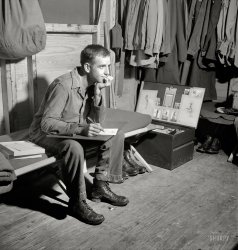
- Rhapsody in Brick: 1940
- ... in Massachusetts." 35mm Kodachrome transparency by Jack Delano. View full size.
Beautiful brickwork. You're right,it is ... Posted by Dave - 05/06/2009 - 11:38pm -
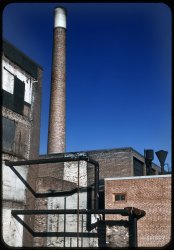
- Way Station: 1943
- ... trains in the concourse of the Union Station." Photo by Jack Delano, Office of War Information. View full size.
Which one is it? Pt ... Posted by Dave - 03/13/2015 - 10:16am -
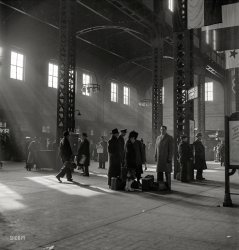
- Teddy the Wrestling Bear: 1941
- ... 1941. View full size. 35mm Kodachrome transparency by Jack Delano.
"Teddy The Wrestling Bear" photo The caption should ... Posted by Dave - 07/29/2012 - 5:58pm -
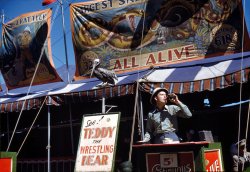
- Go Ahead: 1943
- ... full size. Caption and 4x5 Kodachrome transparency by Jack Delano for the Office of War Information.
(The Gallery, Kodachromes, Jack ... Posted by Dave - 08/30/2012 - 3:29pm -
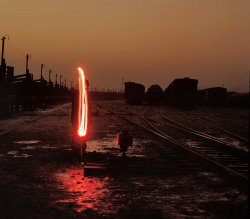
- Near Mist: 1942
- ... An unusually heavy fog in the early afternoon." Photo by Jack Delano for the Office of War Information. View full size.
Da Boyz Is ... Posted by Dave - 03/13/2018 - 11:40am -
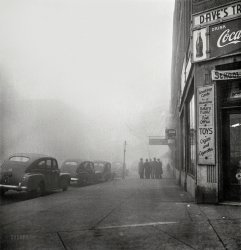
- Proviso Yard: 1942
- ... View full size. 4x5 Kodachrome transparency by Jack Delano.
Proviso Yard Managing a yard like this would take quite a lot of ... Posted by Dave - 08/10/2012 - 4:55pm -
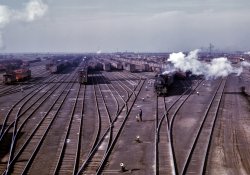
- Slow Train Coming: 1943
- ... Belen and Gallup, New Mexico." Medium-format negative by Jack Delano for the Office of War Information. View full size.
Timz got it ... Posted by Dave - 10/02/2015 - 11:15am -
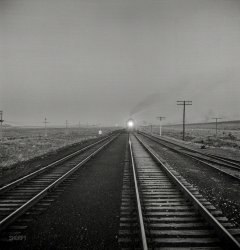
- Soapbox Derby: 1940
- ... in Salisbury, Maryland." 35mm nitrate negative by Jack Delano. View full size.
Dad was such a Hipster Dig those shades, ... from Liberace.
(The Gallery, Cars, Trucks, Buses, Jack Delano, July 4, Kids) ... Posted by Dave - 08/20/2012 - 6:19pm -
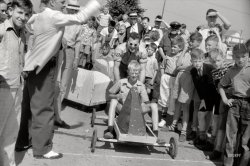
- Light Cleaning: 1943
- ... in accordance with the blackout regulations." Photo by Jack Delano, Office of War Information. View full size.
Afterthoughts ... Posted by Dave - 12/18/2012 - 3:12pm -
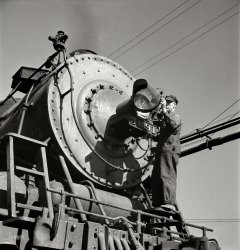
- The Big O: 1943
- ... means 'back up.' Calumet City, Illinois." Kodachrome by Jack Delano. View full size.
Putting the O in OS If you are running MS ... Posted by Dave - 08/30/2012 - 11:59am -
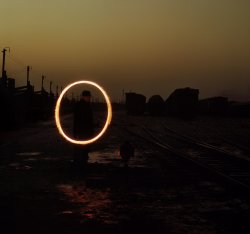
- Weather Center: 1941
- ... other information is constantly being received." Photo by Jack Delano. View full size.
Huh? Having worked in a TTY room, today ... Posted by Dave - 09/26/2019 - 11:32am -
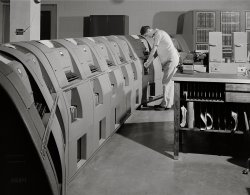
- Partners: 1941
- ... Vermont." View full size. 35mm nitrate negative by Jack Delano for the Farm Security Administration.
Delano-cam If this photo ... Posted by Dave - 05/03/2008 - 1:35am -
![Partners: 1941 September 1941. "Mr. and Mrs. William Gaynor, Farm Security Administration dairy farmers, near Fairfield, Vermont." View full size. 35mm nitrate negative by Jack Delano for the Farm Security Administration.
Delano-camIf this photo was taken today, you'd think they were posing in front of a webcam.
[In a way, it is. - Dave]
PartnersI feel like they're trying to brainwash me, or coax me into something by the way they look." Don't worry, we're not going to hurt you." When really, they need important information from so they can dominate mankind!!!
Two and TwoWhat I like is how they are echoed by the calendar duo behind them. And now that shorpy_is_cool pointed it out, they do seem a little intense...but there's something about their faces that make me think I would like them!
DialupI suppose you could look at it as a webcam with 66.5 years of latency. And to think I complain about my connection speed...
My-In-LawsThese are my husband's parents. His mother died when my husband was around 9, First actual good picture I've ever seen of her. (Actually my husband's never seen such a good picture of her, either.) One of my nieces looks exactly like this photo of the grandmother she never met. Unreal how much alike they look. Back in those days no one liked having their picture taken -- or how to pose for it. Actually my father-in-law has a little smirk on his face, which is far more than I ever saw when I knew him. My husband was the youngest of eight children.
Great Grandma and Great GrandpaThese are my great grandparents! I was searching for William Gaynor with my grandmother, his daughter, and found this picture and many others on the Library of Congress. I never got to meet them unfortunately, but it's so cool to see them and their farm and my grandma light up looking at the photos.
(The Gallery, Jack Delano, Portraits)](https://www.shorpy.com/files/images/8a36837u_0.thumbnail.jpg)
- Meet Me at the Fair: 1941
- ... 1941. View full size. 35mm Kodachrome transparency by Jack Delano.
nice If these ladies are from the circus, is the one on the ... Posted by Dave - 07/29/2012 - 5:57pm -
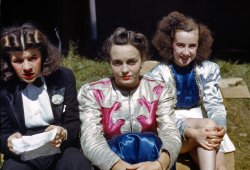
- Country Barber: 1941
- ... shop in Centralhatchee, Heard County, Georgia." Photo by Jack Delano for the Farm Security Administration. View full size.
Maybe ... Posted by Dave - 06/28/2021 - 4:35pm -
